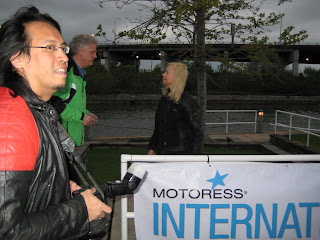Most motorcycle accidents are single-vehicle accidents. It's the nature of the beast: when you're rolling on only two wheels, things happen and you sometimes fall over. Those who haven't learned the ins and outs of push steering for cornering, particularly, often end up in ditches or worse.
But in accidents between a motorcycle and a car, statistically it was the car driver's error the majority of the time. We know we put ourselves in harm's way every time we suit up. Smart riders work on their skills and emergency maneuvers.
Yet that isn't always enough. Cagers (those who drive cars) can be oblivious to anything smaller than their cars. Every motorist who hits a motorcyclist says: "I didn't see him."
They don't see us because they're not looking for us, in part because there aren't as many motorcycles as there are cars. In Europe, where the ratio of motorcycles to cars is much higher, motorcycle fatalities and accidents are lower.
And I have to say from my personal experience, when I was hit, the drivers were not only oblivious to my motorcycle but to traffic in general. And both had callous disregard for the fact they almost ended another human's life. The guy in the Pathfinder who sideswiped me looked at the side of his van before he checked to find out if I was still alive. Then yelled at me for not getting out of his way. He failed to show up for his court date and still got fined only $200.
The woman who hit me and ran felt pretty entitled to leave. Her fine, $400, pretty much validated her opinion. Not much happens to you when you hit and run in Ontario.
It's easy to get angry about the low fines, especially when our system provides no legal recourse for pain and suffering. I was told by a lawyer that if you weren't injured badly enough to keep you from working, there's no point in suing in civil court in Canada. Every day of the four weeks it takes for a broken rib to stop hurting every time you breathe in and out you get a sharp reminder of your powerlessness. As I said, it's easy to get angry about that.
But I'm more interested in the attitudes. And I don't think higher fines would be much more effective at deterring hit and runs or improving driver behaviour.
That would benefit more from better driver education, with dramatic reminders that we're driving 2,000 pound weapons down the road. Driving is a privilege, not a right. Yet the way we train drivers doesn't pound that home. And what we focus on in our laws doesn't either.
The law adopted in Ontario prohibiting the use of cellphones behind the wheel went into force last January. But it has not resulted in people putting down their cell phones. Just this week alone, I narrowly avoided being hit three times by drivers with phones glued to their ears.
And that will continue as long as people remain convinced they're the exception to the rule. According to a study done by the University of Utah, only 2.5 percent of the population are good enough at multi-tasking to drive and talk on the phone at the same time. And the ones who say they can do it are precisely the ones who can't. Those who don't think they can do it are more likely to be able to do it.
I participated in a distracted driving test last January that was organized by Shuan de Jager, founder of Roadawareness.ca, with the help of Scott Marshall, director of training for Young Drivers of Canada. They had us drive go-carts around a track while trying to talk and text on our phones: I drove into a wall trying to text a four-word message.
The National Safety Council in the United States says that drivers are four times more likely to be in a crash if they use cell phones behind the wheel, while drivers who text increase their risk 8 to 23 times.
The source of most of the English public service videos I've found on YouTube that dramatize the repercussions of killing or maiming someone on a motorcycle, whether because of cellphone use or excess speeed, seems to be Australia and the U.K. Both spend money on educating people about the dangers of distracted driving and both have taken what some consider to be shocking approaches. One video that went viral showed ghostly figures watching grieving parents in very graphic accident scene recreations. One of the most popular shows motorcyclists riding their bikes in the buff, with the caption: "Do you see me now?"
Canada doesn't spend federal money on those kinds of ads and I don't recall seeing any produced by a province. Down south, a few states have bankrolled a few.
And 25 out of 50 states have banned using cell phones behind the wheel without the aid of a hands-free device. A few, including Vermont and Illinois, have been cited for launching innovative education programs that teach young drivers, who are particularly at risk because of less experience behind the wheel, of the real dangers of texting while driving. The Associated Press reported that Vermont and Illinois have launched programs that put teens in golf carts and ask them to text while driving the carts. Their experience is very similar to mine.
Such driver awareness exercises really drive home the fallacy of "it can't happen to me" thinking.
2024 The Fundy Adventure Ride
1 year ago









